|
|
|
|
|
|
|
|
|
|
|
|
|
|
|
|
|
|
|
|
|
|
|
|
|
|
|
|
|
|
|
|
 |
 |
|
|
 |
 |
|
|
|
 |
 |
 |
| Written By Roger Winzeler |
| Courtesy of Glass Collectors Digest |
 |
|
|
 |
 |
|
|
|
 |
 |
 |
| With his new Tapestry Ware (pottery and porcelain bases), Samuel Clarke of London featured Thomas Webb Burmese glass shades in three hand-drawn color advertisements from 1888. Webb Burmese was popular, relatively new, and the night light business was "hot." Other full page advertisements in the Pottery Gazette promoted lamps in various styles and types of popular glass (e.g., cameo, verre morie, and satin glass). |
|
| You name it and very likely a fairly light dome, and perhaps a matching base, was made in your favorite glass. There are so many examples of fairy lamps, it makes a collector salivate! In the 1880s, before electricity, these practical and attractive items were a popular choice. |
|
| Colored advertisements must have been expensive, yet Clarke frequently showed fairy lamps in color in the Supplement to the Pottery Gazette (1887-1888). In contrast, I know of only one color advertisement by Thomas Webb (1887) picturing their own Burmese glass, even though this firm had monthly black and white advertisements in the Pottery Gazette. |
 |
|
|
 |
 |
 |
 |
 |
 |
 |
 |
 |
 |
 |
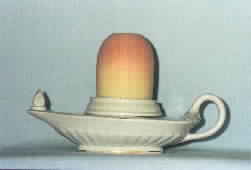 |
|
 |
 |
 |
 |
 |
 |
|
|
|
 |
 |
 |
| Roman Lamp, ivory and gold. No. 240B in Clarke advertisement (Pottery Gazette, December 1, 1888). |
 |
|
|
 |
 |
|
|
|
 |
 |
 |
| So, we have Samuel Clarke to thank for showing many Webb Burmese products in color. In addition to fairy lamps, Clarke advertised elaborate chandeliers and table epergnes. The pictures of the chandeliers are especially impressive. No wonder Queen Victoria and the Sultan of Turkey were customers! |
|
| Samuel Clarke manufactured various kinds of candles at Cricklewood (Child's Hill), a district of greater London. Clarke's Pyramid & Fairy Light Company, Ltd. was not the only firm making candles or marketing candle-burning night lights. In fact, one competitor, the Price Candle Company, eventually purchased the Clarke firm in 1910. In the late 1800s, however, Samuel Clarke set the standard for quality. |
|
| Clarke fiercely defended his patent rights and the Fairy trademark. The firm had made applications to the British Patent Office as early as 1884 for improvement in night lights (squatty candles). Clarke advertised that they didn't use paraffin or other dangerous materials in their candles. |
|
| All the Clarke lamp bases or bowls, flint bottoms, candle cup holders, pressed or blown glass shades (domes), silk shades, and standards of brass, nickel, silver plate, and gut glass were made by other selected companies. Never mind that Samuel Clarke has his name on lamp goods manufactured elsewhere His firm marketed lamps, but it made only candles! |
 |
|
|
 |
 |
 |
 |
 |
 |
 |
 |
 |
 |
 |
 |
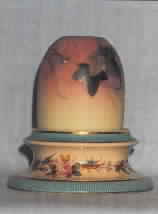 |
 |
 |
 |
 |
 |
 |
 |
 |
 |
|
|
|
 |
 |
 |
| Fairy Pyramid Lamp. No. 274 in Clarke advertisement (August 1888). |
 |
|
|
 |
 |
|
|
|
 |
 |
 |
| To judge from contemporary advertisements and articles, Samuel Clarke was quite promotion minded. The Botanical Society accepted Clarke's offer to provide fairy lamps at its 1886 exhibition. The following year (July 1, 1887) the Pottery Gazette reported: |
 |
|
|
 |
 |
 |
|
|
|
 |
 |
 |
| Visitors to the Queen Victoria's) Jubilee Fete... have a great treat in store for them. At the fete last year, Mr. Samuel Clarke astonished and delighted everyone by his wonderful display of Fairy lamps, which illuminated the grounds in a manner never seen before. Grand as was the display, it will be excelled at the coming fete, when Fairy lamps of the popular Queen's Burmese ware will be very largely used. |
|
| ...We have recently seen at the works of Messrs. Thomas Webb & Sons, Ltd., of Stourbridge, a very large and especially graceful chandelier, carrying 120 Fairy lamps, made entirely of burnished brass work, enriched with conventionalized floral devices, formed of Burmese ware, which is so suitable for Fairy lamps. It is to be hung in the Gardens on the night of the fete. Two others, of similar design and materials, each carrying sixty-eight lamps, will be suspended, on on either side of it, and these will be surrounded by nearly a hundred others, all in harmony with the above, the whole of which have been designed and manufactured by Messrs. T. Webb for this special occasion, to the order of Mr. S. Clarke.... The total number of Fairy lights being supplied for this fete reaches 23,000, and some pretty effects and charming designs may be anticipated.... |
 |
|
|
 |
 |
 |
 |
 |
 |
 |
 |
 |
 |
 |
 |
 |
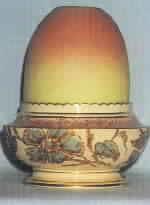 |
|
 |
 |
 |
 |
 |
 |
 |
 |
 |
|
|
|
 |
 |
 |
| Fairy Lamp. No. 243 in Clarke advertisement (June 1888). |
 |
|
|
 |
 |
|
|
|
 |
 |
 |
| Later the Pottery Gazette (June 1, 1888) reported that Samuel Clarke would display a 500-light Fairy Pyramid chandelier. Twelve feet in length and weighing 500lbs., it was designed to hang from the center dome of the conservatory in the Royal Botanic Society's Gardens, Regent's Park, London at the Society's Fete. Clarke advertised, "The offensive oil lamps will not be used in any part of the Gardens." |
|
| No expense was spared for these fetes, but Samuel Clarke must have reaped great advertising rewards. His lamps and candles were not only patented in Great Britain but in other countries like France, Belgium, Austria, Spain, Russia, and the United States. Trademarks were registered as well. Clarke exhibited at the Chicago World's Fair of 1893. He had showrooms at 132 Regent Street in London. |
|
| Samuel Clarke also sold watch holders, menu holders, food warmers, vaporizers and inhalers, epergnes, pendants, and materials to convert chandeliers and candlesticks to use various sizes of Clarke candles. Besides the usual tapers, there were squatty candles with a thick plaster shell to burn alone without the protection of glass. This product was called a Pyramid. |
 |
|
|
 |
 |
 |
 |
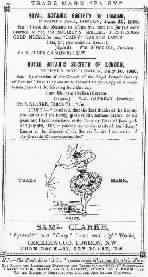 |
 |
 |
 |
 |
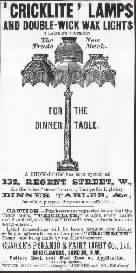 |
 |
 |
 |
 |
 |
 |
|
|
|
 |
 |
 |
| 1899 Cricklite Lamps advertisement. Metal frames covered in silk rest on glass shades. |
 |
|
|
 |
|
|
|
 |
 |
 |
| The Fairy trademark, but not necessarily the same impressed design found on clear glass bases. Registered December 1, 1886. |
 |
|
|
|
 |
 |
|
|
|
 |
 |
 |
| Many Burmese objects, like vases and fairy lights, were practical and must have enjoyed good use. Burmese was blown to be quite thin. It is remarkable that some of the glass has survived the past hundred years. |
|
| Chandeliers or pendants would have been too expensive for the average worker earning 25 shillings a week. In a contemporary price list, a 110-light chandelier in undecorated Burmese ware cost 70 shillings wholesale. Obviously, a single Burmese unit was much cheaper -- 12 shillings per dozen wholesale. Except for cameo items, other glass lamps were less expensive than Burmese. |
|
| The Wee Fairy was the smallest squatty candle. Made to burn three or four hours, it had a single wick and was packaged in a box with eleven lights and a candle cup. Next in the squatty line was the Fairy Pyramid. The double-wick version burned up to six hours, and a single-wick up to ten hours. These came with six or eight lights and a glass candle holder in one box. |
 |
|
|
 |
 |
 |
 |
 |
 |
 |
 |
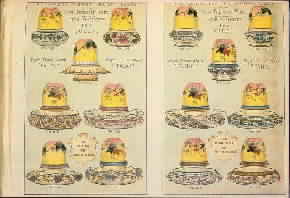 |
 |
 |
 |
 |
 |
|
|
|
 |
 |
 |
| Fairy Lamp and Flower Bowl advertisement, Pottery Gazette, |
| June 1, 1888. |
 |
|
|
 |
 |
|
|
|
 |
 |
 |
| The Fairy and Cricklite domes were a similar size and thus interchangeable but not necessarily the candles. The clear glass of the Cricklite was used more for dining rooms, lamp standards, and ceiling fixtures. The name Cricklite came from Crickwood, the area of greater London where the Clarke candle factory was situated. |
|
| The candles that had a double rush wick gave superior light. The rush was peeled in such a manner that, when burning, it curved in opposite directions. There was a thin plaster base to anchor the wick, since the squatty candles in the glass candle cup soon became soft and melted. There were twelve Cricklite candles in a box and the double wicks would burn five hours. Fairy lights could be purchased that burned six or ten hours. |
|
| Some registration dates for trademarks by Samuel Clarke are: Pyramid night light (No. 1012, applied for January 18,1876, but in use 14 years before this date); Burglar's Horror (No. 36, 286, March 1884); Fairy (No. 45, 771, June 1885); Fairy Pyramid (No. 61, 201, January 20, 1887); Wee Fairy (No. 68, 346, October 1887); and Cricklite (No. and date unknown, c. 1889 or later). As you can see, most trademarks were in use before the production of Webb Burmese. Cricklite is later than any of the other candle-burning lamps. |
 |
|
|
 |
 |
 |
 |
 |
 |
 |
 |
 |
 |
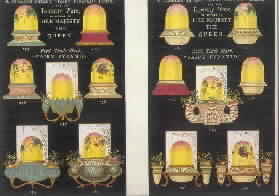 |
|
 |
 |
 |
 |
 |
|
|
|
 |
 |
 |
| Fairy Pyramid advertisement, Pottery Gazette, August 1, 1888. |
 |
|
|
 |
 |
|
|
|
 |
 |
 |
| It may seem ironic, but Thomas Webb & Sons registered their trademark for Burmese on September 11, 1886 (No. 56, 664) just days before the Mount Washington Glass Company registered their British number (No. 56, 859, September 18, 1886). Mount Washington granted the English firm, Thomas Webb, patent rights to manufacture Burmese. Mount Washington patented its Burmese in the United States on December 16, 1885. |
|
| The Roman Lamp in Photo 1 is shown in the Fairy Pyramid size with the dome measuring 2 3/4" tall and 2 3/8" in diameter. This lamp was also available in the larger Fairy size (3 3/4" t., 3 1/8"d.). Made in Germany, the lamp base has the English Registered No. 93321 stamped on the bottom. This number would be from 1888 according to Table of Design Registration Numbers on English Wares. |
|
| The advertisement from the Supplement to the Pottery Gazette featuring the Roman Lamp was the same year (1888). Without a German manufacturer's mark, it is difficult to know who made these Roman Lamps. Not all lamps were sold as complete unites. Clarke sold other bowls and glass shade separately, so mixing and matching shades to the bases must have been common. |
 |
|
|
 |
 |
 |
 |
 |
 |
 |
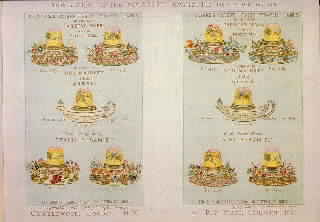 |
 |
 |
 |
 |
 |
|
|
|
 |
 |
 |
| Fairy Pyramid advertisement showing Roman Lamp, Pottery Gazette, December 1, 1888. |
 |
|
|
 |
 |
|
|
|
 |
 |
 |
| The pottery night light bases in Photo 2 (Fairy Pyramid size) and Photo 3 (Fairy size) are well marked with the Clarke name, but the real manufacturer's logo appears printed on the bottom of the base. The circled monogram topped with a crown identifies the maker as the English firm of Taylor, Tunnicliff & Co., Ltd. When researching English pottery, I recommend Encyclopedia of British Pottery and Porcelain Marks by Geoffery A. Godden (London: Barrie & Jenkins, Ltd.). |
|
| Those readers wanting more information about candle-burning night lights and Samuel Clarke's Fairy Lamps, can try to locate the following three books. Unfortunately, all are out of print. |
|
| Clarke's Fairy-Lamps by Dorothy Tibbets (Huntington Park, CA: Mission Press, 1951) has several pages of Clarke advertisements and wonderful examples of candle-burning night lamps from various companies, all in black and white. |
|
| Fairy Lamps, Evening's Glow of Yesteryear by Amelia E. MacSwiggan (New York: Bonanza Books, 1962) features good historical information, reproductions of a few early Clarke advertisements, and black and white pages showing unusual candle-burning night lamps. The text is highly readable. |
|
| 19th Century Fairy Lamps by T. Robert Anthony (Manchester, VT: Forward's Color Productions, Inc., 1969) has beautiful examples of fairy lamps in color with individual descriptions. It makes you wish you had started your collection in the 1930s! |
|
| Roger Winzeler is a collector who makes his home in Missouri. He has a special interest in the Burmese glass of Thomas Webb & Sons. |
 |
|
|
 |
 |
 |
 |
 |
 |
 |
 |
 |
 |
 |
 |
 |
 |
|







